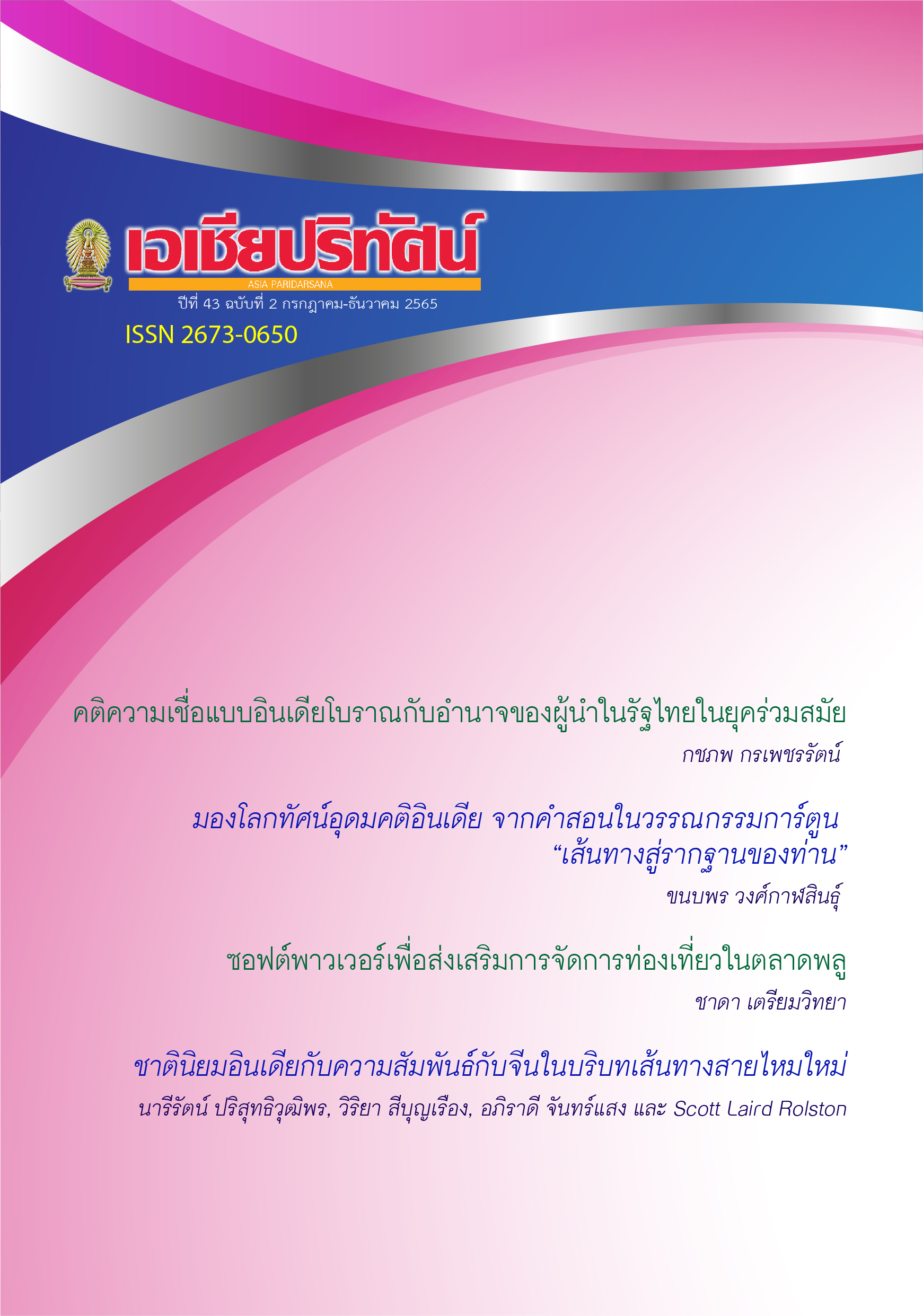Indian Nationalism in Relation to China towards the Context of New Silk Road
Main Article Content
Abstract
There were two purposes in this study: to find out a relationship between India and China focusing on a project of One Belt One Road from 2013 and to present (2021), and to explore causes of obstacles between the two countries during the project launch. As the research methodology, the concepts of nationalism and national interest were used to describe the project’s phenomenon.
The findings showed that there were conflicts between India and China all the time from the past. Since the economic reform in 1991, India has accelerated its economy by encouraging private sectors for commerce as well as the foreign investments. The most investors in India became China. Since then, there were 3 periods of relationship alteration. From 2013 to 2015, the relationship between India and China appeared untroubled. From 2016 to 2019, India was suspicious China due to its CPEC in Pakistan. From 2020 to 2021, there has been conflicts along the Galwan River Valley.
Article Details

This work is licensed under a Creative Commons Attribution-NonCommercial-NoDerivatives 4.0 International License.
บทความทุกบทความเป็นลิขสิทธิ์ของสถาบันเอเชียศึกษา ดูตัวอย่างอื่นประกอบReferences
รายการอ้างอิง
ภาษาไทย
กรมส่งเสริมการส่งออก. 2555. การประชุมร่วมสองฝ่าย อินเดีย-จีน ว่าด้วยความสัมพันธ์ทางเศรษฐกิจ การค้า วิทยาศาสตร์และเทคโนโลยี ครั้งที่ 9 ณ กรุงนิวเดลี อินเดีย. เข้าถึง 10 กันยายน 2564. https://www.ryt9.com/s/expd/157389
โคริน เฟื่องเกษม. 2536. นโยบายต่างประเทศและการตอบสนองผลประโยชน์ของชาติ : การวิเคราะห์ ผลงาน ด้านการต่างประเทศในสมัยรัฐบาล ชวน หลีกภัย (ตุลาคม พ.ศ.2535-2536). กรุงเทพฯ : โรงพิมพ์สำนักงานกองทุนสนับสนุนการวิจัย.
จินดานันท์ บำรุงจิตร. 2561. “ความสัมพันธ์ระหว่างอินเดีบกับจีน ระหว่างค.ศ.1991-2014” .วิทยานิพนธ์รัฐศาสตรมหาบัณฑิต,มหาวิทยาลัยธรรมศาสตร์.
“จีน-อินเดีย” ยากแตกหัก เศรษฐกิจ-เทคโนโลยีเชื่อมโยงแน่น”. 2563 . ประชาชาติธุรกิจ. เข้าถึง 20 กันยายน 2564. https://www.prachachat.net/world-news/news-480222
“จับตาอนาคตอินเดีย วันข้างหน้า...ที่ไม่เป็นรองจีน”. 2553 .โพสต์ทูเดย์ . เข้าถึง 5 ตุลาคม 2564. https://www.posttoday.com/politic/analysis/53103
“จับตาพิพาทจีน-อินเดีย สู่สงครามการค้า! “Huawei” เลิกจ้างพนักงานในอินเดีย-หั่นเป้ารายได้ปี 2020”. 2563. brandbuffet . เข้าถึง 27 ตุลาคม 2564 . https://www.brandbuffet.in.th/2020/07/huawei-cuts-india-revenue-target-and-layoff-staff/
ฐิติพร พันธุ์ท่าช้าง. 2564 . “การพัฒนาเมืองอย่างยั่งยืนกรณีศึกษา กรณีศึกษา กรุงเดลี และเมืองชัยปุระ สาธารณรัฐอินเดีย”. วารสารมนุษยศาสตร์และสังคมศาสตร์ มหาวิทยาลัยพะเยา 9(1) : 279-299
นพรัตน์ ทองอุไร. 2557. “การก้าวขึ้นสู่ฐานะมหาอำนาจใหม่อินเดีย”. วารสารสังคมศาสตร์ 10(1) : 5-39.
บัณฑิต อารอมัน. 2562. “การแผ่อิทธิพลจีนในเอเชียใต้ผ่านเส้นทางสายไหม”. เอเชียปริทัศน์ 40(1) : 101-134.
ปิติ ศรีแสงนาม. 2561. “Sagar Mala สาครธาราที่เชื่อมถึงกัน”. ผู้จัดการ, เข้าถึง 21 ตุลาคม 2564. ttps://mgronline.com/daily/detail/9610000072550
พจน์ พงศ์สุวรรณ. 2536. หลักยุทธศาสตร์. พิมพ์ครั้งที่ 2. กรุงเทพฯ : สำนักพิมพ์ โอ.เอส.พริ้นติ้งเฮาส์.
มาโนชญ์ อารีย์. 2563. เปิดภูมิหลังความขัดแย้งจีน-อินเดีย จากปัญหาพรมแดนโหมกระพือกระแสชาตินิยม และโอกาสเกิดสงครามใหญ่. เข้าถึง 24 กันยายน 2564 https://thestandard.co/china-india-border-conflict/
ลิขิต ธีรเวคิน. 2514. อุดมการณ์ทางการเมืองและการพัฒนาประเทศไทย ใน ฉัตรทิพย์ นารถสุภา (บก.). อุดมการกับสังคมไทย. กรุงเทพฯ: สมาคมสังคมศาสตร์แห่งประเทศไทย.
สถานกงสุลใหญ่ ณ เมืองมุมไบ. 2553. “เศรษฐกิจอินเดีย” . ข่าวเศรษฐกิจ. เข้าถึง 12 กันยายน 2564. https://mumbai.thaiembassy.org/th/content/17920-%E0%B9%80%E0%B8%A8%E0%B8%A3%E0%B8%A9%E0%B8%90%E0%B8%81%E0%B8%B4%E0%B8%88%E0%B8%82%E0%B8%AD%E0%B8%87%E0%B8%AD%E0%B8%B4%E0%B8%99%E0%B9%80%E0%B8%94%E0%B8%B5%E0%B8%A2?cate=5d74ff3715e39c0a7c000fed
สาธิต มนัสสุรกุล. 2561. “ญี่ปุ่น อินเดีย สหรัฐฯ ออสเตรเลียจะรวกันสู้ ‘เส้นทางสายไหมใหม่’ของจีน ?” Momentum. เข้าถึง 16 กันยายน 2564 https://themomentum.co/author/sathitm/
“ศรีลังกาขายท่าเรือฮัมบันโตตาให้จีน”. 2560. เดลินิวส์. เข้าถึง 11ตุลาคม 2564. https://d.dailynews.co.th/foreign/587660/
““อยากเอาคืน แต่ทำไม่ได้” ผู้เชี่ยวชาญเตือน อินเดียบอยคอตจีน สุดท้ายอาจเดือดร้อนเอง”. 2563. แบรนด์อินไซด์ . เข้าถึง 30กันยายน 2564. https://brandinside.asia/india-boycott-china/
ภาษาต่างประเทศ
Andrew Heywood, 2007. Political Ideologies : an Introduction New York : Palgrave Macmillan.
Hongzhou Zhang, Mingjiang Li. 2013. Sino-Indian Border Disputes. accessed Oct. 10,2021 http://www.ispionline.it /sites/default /files/pubblica zioni/analysis_181_2013.pdf.
Mohan Guruswamy, 2003 . “The Great India-China Game,” Rediff, accessed Oct. 15, 2021, https://www. rediff.com/news/2003/jun/20spec.htm.
Puyam Rakesh Singh. 2019. “Emerging Security Dynamics in India-China Relations in the Indo-Pacific region” Diplomatist . accessed Oct 26 2021. https://diplomatist.com/2019/12/26/emerging-security-dynamics-in-india-china-relations-in-the-indo-pacific-region/


